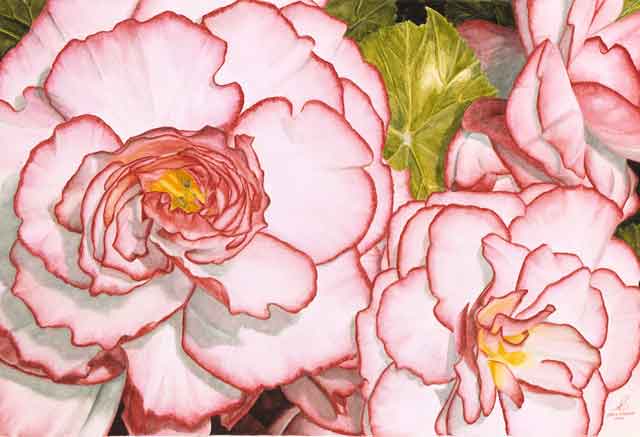
Growing Begonias Indoors
Introduction
Growing begonias properly requires a basic understanding of growing flowers, which will be covered in this article, but above all, it comes down to patience and a little knowledge. You don’t have to have hardened green fingers to grow your own large beautiful begonias in your home.

Lighting and location
The most important thing to take into consideration when growing begonias is to decide on the best place in the house to grow them in, which should be well ventilated and not too close to strong heat sources such as a radiator, as this can cause the growing medium and the plant to dry out too quickly, and can result in the plants untimely demise.
Good lighting is critical to ensuring your plants survival, while it is not difficult to get your plant the life-giving light in needs, it is also very easy to overlook this fact and place your plant in a location where it doesn’t get enough light, in other words, putting your begonias on the top of your cupboard wont do any good. A well lit window sill will do a fine job at giving your plants light, also, the natural day/night cycle means you wont have to worry as much about when it’s getting light.
If you want to use artificial lighting for your plants, there is pretty much no type of growing light that you can’t use, even a small 60 watt lamp placed far enough away from the plant so it doesn’t burn is more than sufficient for it. Using artificial lighting instead of using the free energy the plant could get from the sun may seem foolish, but it does however boast advantages, the main one being that you can keep the light on it 24 hours a day – constantly. This will boast a larger plant with brighter , more colourful flowers, also you wont have to worry about those overcast days where the plant may not be getting enough light to maintain healthy growth.

Growth media and potting
The growing medium you use and the potting methods you apply to your begonias are imperative to insuring a strong healthy growth, and using the right method makes all the difference.
When growing indoors it is important to remember to always stay away from soil mixtures if possible, as soil is generally not suitable for growing begonias as they need a lot of nutrients which most soil doesn’t contain. Instead, using a peat-based mix such as Sunshine or Fafard are generally the best mediums to grow your begonias in, as they are rich in nutrients that are vital to the plants’ growth and allows water to quickly and easily filter, meaning the flowers’ roots are not sitting in stale water, which can cause root rot – which is never a good thing.
It is also important to remember that begonias cannot cope well with being over potted, and by that, I mean you must avoid using pots that are too large for the plant when it is at a young age, instead you must wait until the flower is maturing in a smaller pot before transferring it over to a larger one. This ensures that its roots have properly filled out the smaller pot, meaning that when transferred to a larger pot, the roots now have the space and the need to grow more.
Watering and nutrients
Watering is perhaps the most common area where people make mistakes when it comes to growing plants, usually by over watering them. Most plants cannot live in over watered growing medium, and begonias are no exception – they simply cannot tolerate it. Personally, I find that when growing flowering plants, usually the best method to determine when to water them is to simply push a finger into the growing medium, and if it is dry more than 1 inch below the surface, it Is time to water. The quantity of water they need is also largely dependant on the size and age of the plant, e.g. a small, young plant wont need to be watered as much as a larger plant, as it is smaller, it will have smaller roots, meaning less water will be absorbed in the same time scale.
As far as nutrients go, pretty much any fertilizer designed for flowering plants will do, simply add a few drops to the water each time you feed your plant, be careful not to over-feed it with nutrients though, as this can cause the leaves to dry up and die – remember, growing flowers is not a race, it takes time.
Pruning
From time to time you may have to prune your plants, this is necessary when the plant has flowers on it which are noticeably deformed and or overly dry, this is easy to resolve, simply pinch the bottom of the flower it self and pull off, or failing that simply use some scissors, be sure not to cut too much off the plant itself or you risk damaging it too much. After successfully pruning your plant it should take around less than a week for you to start to notice a new, fresh flower starting to grow where you removed the old one.
Conclusion
Following this guide should give you all the tools you need to efficiently grow your own begonia flowers, take time to enjoy the hobby, and good luck!
